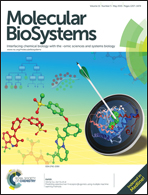Perturbations in inter-domain associations may trigger the onset of pathogenic transformations in PrPC: insights from atomistic simulations†
Abstract
Conversion of the predominantly α-helical cellular prion protein (PrPC) to the misfolded β-sheet enriched Scrapie form (PrPSc) is a critical event in prion pathogenesis. However, the conformational triggers that lead to the isoform conversion (PrPC to PrPSc) remain obscure, and conjectures about the role of unusually hydrophilic, short helix H1 of the C-terminal globular domain in the transition are varied. Helix H1 is anchored to helix H3 via a few stabilizing polar interactions. We have employed fully atomistic molecular dynamics simulations to study the effects triggered by a minor perturbation in the network of these non-bonded interactions in PrPC. The elimination of just one of the key H1–H3 hydrogen bonds led to a cascade of conformational changes that are consistent with those observed in partially unfolded intermediates of PrPC, with pathogenic mutations and in low pH environments. Our analyses reveal that the perturbation results in the enhanced conformational flexibility of the protein. The resultant enhancement in the dynamics leads to overall increased solvent exposure of the hydrophobic core residues and concomitant disruption of the H1–H3 inter-domain salt bridge network. This study lends credence to the hypothesis that perturbing the cooperativity of the stabilizing interactions in the PrPC globular domain can critically affect its dynamics and may lead to structural transitions of pathological relevance.


 Please wait while we load your content...
Please wait while we load your content...